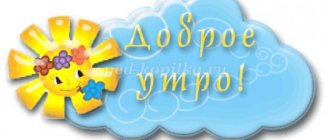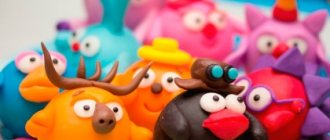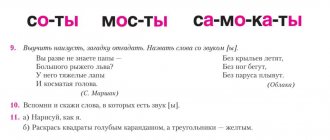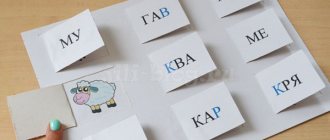Teaching literacy in kindergarten.
Literacy instruction in kindergarten is a focused, systematic process to prepare for mastery of writing and reading. The wrong approach to literacy teaching can lead to additional learning problems. Teaching literacy in kindergarten is a propaedeutic for dyslexia and dysgraphia and will help the child avoid some specific mistakes.
Literacy learning is perceived by many teachers and parents only as a process of learning to read; this is too narrow a view of this issue.
The literacy process consists of the following components:
- Formation of the sound side of speech, i.e. the child must have correct, clear pronunciation of the sounds of all phonemic groups: whistling (s.z.ts), hissing (sh, zh), africates (ch, sch), sonorants (l, r);
- Formation of phonemic processes, i.e. the ability to hear, distinguish and differentiate the sounds of the native language;
- Readiness for sound-letter analysis and synthesis, i.e. the ability to isolate the initial vowel from a word; analyze vowel sounds; analysis of reverse syllables; hear and highlight the first and last consonant sound in a word: Introducing children to the terms: “sound”, “syllable”, “word”, “sentence”, sounds vowels, consonants, hard, soft, deaf, voiced. To develop the ability to work with word diagrams, split alphabet and possess syllable reading skills.
Stages of literacy work.
Preparatory stage.
Introduction to non-speech sounds.
Work begins with familiarization with non-speech sounds. At this stage, the concept of “sound” is given.
- first, sounds that are very contrasting in sound are given (pipe-drum);
- then sounds similar in sound (big tambourine - small tambourine);
- recognition and differentiation of various noises (rustling of paper, foil; knocking of pencils, pens, spoons).
Suggested games:
- “If you hear it, clap”;
- “Find out what it sounds like?”;
- “Where does the bell sound?”;
- "Show picture";
- "Loud quiet";
- "Who said?".
At this stage, work is carried out on dividing words into parts (syllables); children determine the number of parts (syllables) through clapping, steps, bending their fingers, and squatting.
We use games in accordance with the lexical topic, for example, when studying the topic “Vegetables,” we divide the words into syllables: onion, cabbage, zucchini, pepper.
And in accordance with this, we use the following teaching aids:
- trains: the number of cars corresponds to the number of syllables;
- garages: the number on the garage corresponds to the number of syllables in the car names;
- domino: the number of dots corresponds to the number of syllables, etc.
Stage I
.
Introducing vowel sounds.
Getting to know sound begins with isolating sound from speech. Let's take a closer look at the sound [and]. We tell the children that the donkey is carrying a heavy cart and shouts E-I-I. Next we ask the children, how does the donkey scream? Children look in the mirrors and examine the articulation of the pronunciation of the sound, their lips stretch into a smile (we use a symbol). Considering the articulation of sound, we find out that the air does not meet any obstacles, which means this sound is a vowel (we use a red circle). We say that the voice is involved in the formation of sound; it can be sung. Acquaintance with other vowel sounds occurs in a similar way. After becoming familiar with the sounds, games are played using symbols of vowel sounds.
Suggested games:
- “Name the sound”: the speech therapist shows the articulation of the sound, the children name it.
- “Show the sound”: the speech therapist pronounces the sound, the children show a symbol card.
- “Name the first sound in the words: stork, bus, ears, Ira, hoop.”
- “Name the last sound in the words: winter, boots, road.”
- “Name words with the sound [a], [o], etc.”
After becoming familiar with the sounds, work is carried out to differentiate vowels, to clarify articulation and the ability to hear a given sound:
- “Arrange the pictures”: give the doll Olya pictures whose names contain the sound [o], and Anya - the sound [a].
At this stage, we teach children to hear vowel sounds, for example the sound [a]
- among other sounds: a, u, i, a, a, o
- in a series of syllables: om, um, am, an, as.
- in a series of words: stork, mustache, artist, wasps
- in the text: Anya and Alik were walking, collecting asters in the garden.
At this stage, work is being done on the position of the sound in the word:
- First, teach children to identify the first sound in a word. The teacher needs to highlight the desired sound with his voice, intonation and reinforce it with a symbol;
- Then it is necessary to teach children to hear and isolate the sound at the end of a word;
- In the middle of a word.
To do this, we use a guide - sound lines.
At this stage, the simplest sound analysis of words (ay, ua, ia) is introduced, the number of sounds, order, and characteristics are determined. Consider the word AU. Children pronounce the word, determine the first sound, the second sound. Give a description of each sound. Determine the number of sounds in a word and their sequence. Each sound is indicated by a corresponding letter, after which the word is read.
Stage II. Introducing consonant sounds.
When getting acquainted with each sound, its full characteristics are given, based on tactile, visual, auditory, and motor analyzers. Children learn that sound can be heard, articulation seen, and felt.
Let's take a closer look at getting to know the sound [m] - consonant, voiced, hard.
You can tell the children: a young cow does not yet know how to really moo. She does it M-M-M. (We use cards-symbols of sounds by Z.E. Agranovich). Next, the children pronounce the sound themselves and look in individual mirrors. Together with the children, it turns out that the air meets an obstacle - the lips, which means the sound is a consonant.
To determine the voicedness and deafness of a consonant, we use the technique with the neck - if the neck “rings”, then the sound is voiced, if not, it is dull.
If your neck is ringing,
So the ringing sound is running.
In this case, the sound [m] is voiced (we use the symbol - bell). To indicate hardness or softness, the following symbols are used: nut - hard, cloud - soft.
Much work is being done to differentiate sounds according to acoustic (T-D, G-K, B-P) and articulatory (S-Sh, T-K, Z-Zh) characteristics. Each sound is characterized in detail, then these characteristics are compared. Children, under the guidance of a teacher, find out how they are similar and different.
Introducing letters.
At this stage we begin to introduce children to letters. In our work, we call the letter as a sound: “sh”, not “sha”; “l”, not “el”. Otherwise, the child will not understand how to merge the syllables.
We introduce children to the rule: “ We pronounce and hear sounds, but we see and write letters.”
We help the child remember the letter through associations. We ask children to look at the letter and imagine what it looks like. All answers are accepted, and your own version is offered, in which the picture looks like a letter and begins with a given sound (s - cheese, t - pipe, i - apple).
The elements and their quantity are considered. You can offer a poem to remember the image of a letter:
- The wheel rolled and turned into the letter O;
- U is a twig, in any forest you will see the letter U;
- A - as the ladder stands, the alphabet begins;
- Letter B with a large belly, wearing a cap with a long visor;
Memorizing the image of a letter can be organized in different ways, using different analyzers.
- Write a letter in the air on the table;
- Lay out a printed letter from pencils, counting sticks, laces, strings;
- Write the letter with your finger on semolina or other small grains;
- Lay out a letter from large and small buttons, beads, beans and other small items;
- Treat yourself to a letter-shaped cookie;
- Model from plasticine, dough;
- Select (underline) the desired letter in the text.
When getting acquainted with consonant sounds, work is carried out on sound analysis:
- reverse syllables (um, he, am, an);
- straight syllables (mu, na, but);
- monosyllabic words without consonants (house, smoke, cat);
- two-syllable words with straight open syllables (cinema, cotton wool, perfume);
- monosyllabic with a consonant cluster (table, mole, bridge);
- two-syllable words with a cluster of consonants (skala);
- three-syllable words with straight open syllables (raspberry).
We take the word for sound analysis from the lexical topic that we are going through at the moment. Let's take a closer look at the sound analysis of the word WINTER (the picture winter appears). The word symbol is a stripe, the syllables are short stripes. Next, we perform a sound analysis of each syllable. Let's designate each sound with the corresponding letter. There are many techniques for working with word schema:
- name the number of sounds in a word;
- name the sounds in order;
- How many vowel sounds are there in a word? Name them in order;
- how many consonants;
- name the first sound, the last, the third.
After a detailed sound analysis of the word, we designate each sound with the corresponding letter. The word is read, written down in a notebook, and placed in the letter box. You can create a sentence or phrase with this word.
Literacy training
- a crucial period in a child’s life. And how well it will go depends largely on you, your patience and goodwill. Let him feel the success of completing every task.
The consultation was prepared by a speech therapist: Shkurova O.V.
Literature:
- Z.E. Agranovich. To help speech therapists and parents. St. Petersburg, 2007.
- S.P. Tsukanova, L.A. Betz. We teach the child to speak and read. Moscow, 2008.
- N.S. Varentsova. Teaching preschoolers literacy. Moscow, 2009.




